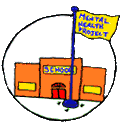

|
It's About Much More than Full Service |
California's Superintendent of Education has just released A Blueprint For Great Schools http://www.cde.ca.gov/eo/in/bp/bpstrategy6.asp
There is much in the blueprint to be commended. As with President Obama's blueprint, it even includes some specific attention to "education supports." Thus, concern about addressing barriers to learning is not ignored, but the way "education support" is discussed moves the concern right back into a marginalized status with respect to improving how schools enhance equity of opportunity for all students to succeed at school and in their future lives.
What's missing is a fundamental shift in thinking about the way school improvement policy and practice needs to change in order to fully address barriers to learning and teaching and re-engage disconnected students.
For example, the report stresses that schools should be encouraged to adopt a community school approach.
We love the idea of a Comprehensive Community School, but we continue to be worried about how people understand what that is.
It is well to remember there is great variability among what are called Community Schools. In particular, it is essential to differentiate those that are mainly interested in enhancing connections with community agencies from those committed to a vision for developing a comprehensive school-family-community collaborative. It is the latter that have the greatest potential for addressing the whole child and for doing so in ways that strengthen families, schools, and neighborhoods. In contrast, focusing primarily on linking community services to schools colludes with tendencies to downplay the role of existing school and other community and family resources. It also contributes to perpetuation of approaches that overemphasize individually prescribed services, further fragment intervention, and underutilize the human and social capital indigenous to every neighborhood. All this is incompatible with developing the type of unified and comprehensive system needed to effectively address barriers to learning and teaching and re-engage disconnected students.
(For more on this, see the Center policy briefs:
- Understanding Community Schools as Collaboratives for System Building to Address Barriers and Promote Well-Being online at https://smhp.psych.ucla.edu/pdfdocs/communitycollab.pdf
- Pursuing Promise Neighborhoods: With or Without the Grant Program online at https://smhp.psych.ucla.edu/pdfdocs/purpromneig.pdf)
Developing a unified and comprehensive system entails:
- unifying all direct efforts to address factors interfering with learning and teaching at a school
-- starting with rethinking and restructuring the work of district/school- funded student and learning support professionals
- connecting families of schools (such as feeder patterns) with each other and with a wider range of community resources
- weaving together school, home, and community resources in ways that enhance effectiveness and achieve economies of scale.
Work related to pioneering initiatives around the country is providing realistic and cost-effective guidance for operationalizing the component (see https://smhp.psych.ucla.edu/summit2002/trailblazing.htm). The emphasis is on
- rethinking and coalescing existing student and learning support programs, services and personnel in order to develop a unified and comprehensive system
- reworking operational infrastructure to weave together different funding streams, reduce redundancy, and redeploy available resources at school and from the community.
At the state and regional levels, it is time and it is essential for education agencies to reorganize student and learning supports into a cohesive unit and provide guidance and capacity building support for districts to build a comprehensive, multifaceted, and integrated system of learning supports.
At the district and school level, it is time and it is essential to go beyond thinking in terms of providing traditional services, linking with and collocating agency resources, and enhancing coordination. These all have a place, but they do not address how to unify and reconceive ways to better meet the needs of the many, rather than just providing traditional services to a relatively few students.
NOTE:
If you think we are simply talking about improving coordination of existing programs, services, and personnel, please delve deeper. While coordination certainly is part of the picture, the essence of our focus on transforming student and learning supports involves development of a unified and comprehensive system. This calls for (1) integrating existing school resources into an enabling/learning supports component, (2) integrating the component fully into school improvement planning, and (3) integrating with community resources to fill gaps in the component. With this accomplished, the concern then becomes that of ensuring coordinated implementation within and across school and community.
Dictionary definitions help clarify the distinction between coordination and integration:
- "Coordinate: to act in harmonious combination, to work together"
- "Integrate: to bring together or incorporate parts into a whole; to combine into one unified system"
Pioneering initiatives are moving to develop a unified and comprehensive enabling/learning supports component as a fundamental function in their school improvement plans These initiatives are pushing beyond individual and small group services and ideas such as linking with and collocating agency resources and enhancing coordination. No one denies that such strategies have a place. But the need is for unifying and reconceiving supports and fully integrating them with direct instructional and management efforts to better meet the needs of all students.
Ongoing Hot Issue
Back to Hot Topics Home Page
|
Want more information? Want to connect? Want to be on our mailing list? Click here to sign up. |
|
School Mental Health Project-UCLA Center for Mental Health in Schools WebMaster: Perry Nelson (smhp@ucla.edu) |
 |